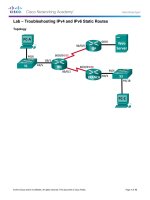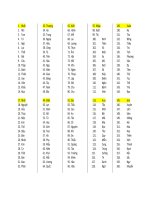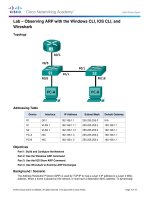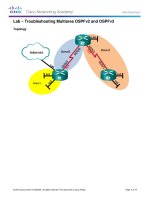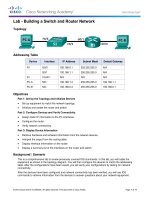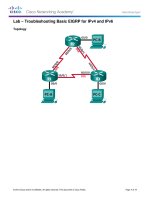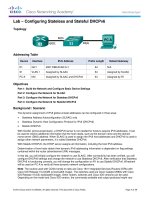Pearson CompTIA aplus 220 701 and 220 702 practice questions exam cram 4th edition 078974791x kho tài liệu bách khoa
Bạn đang xem bản rút gọn của tài liệu. Xem và tải ngay bản đầy đủ của tài liệu tại đây (1.61 MB, 421 trang )
®
CompTIA A+
220-701 and
220-702
Practice
Questions
Fourth Edition
Patrick Regan
CompTIA® A+ 220-701 and 220-702 Practice Questions Exam
Cram, Fourth Edition
Publisher
Paul Boger
Copyright © 2011 by Pearson Education, Inc.
Associate Publisher
David Dusthimer
All rights reserved. No part of this book shall be reproduced, stored in a retrieval system, or transmitted by any means, electronic, mechanical, photocopying, recording, or
otherwise, without written permission from the publisher. No patent liability is
assumed with respect to the use of the information contained herein. Although every
precaution has been taken in the preparation of this book, the publisher and author
assume no responsibility for errors or omissions. Nor is any liability assumed for damages resulting from the use of the information contained herein.
ISBN-13: 978-0-7897-4791-4
ISBN-10: 0-7897-4791-X
Trademarks
All terms mentioned in this book that are known to be trademarks or service marks
have been appropriately capitalized. Pearson Education, Inc. cannot attest to the accuracy of this information. Use of a term in this book should not be regarded as affecting
the validity of any trademark or service mark.
CompTIA is a registered trademark of CompTIA.
Warning and Disclaimer
Every effort has been made to make this book as complete and as accurate as possible, but no warranty or fitness is implied. The information provided is on an “as is”
basis. The author and the publisher shall have neither liability nor responsibility to any
person or entity with respect to any loss or damages arising from the information contained in this book or from the use of the CD or programs accompanying it.
Bulk Sales
Pearson Education, Inc. offers excellent discounts on this book when ordered in quantity for bulk purchases or special sales. For more information, please contact
U.S. Corporate and Government Sales
1-800-382-3419
For sales outside the United States, please contact
International Sales
Acquisitions Editor
Betsy Brown
Senior Development
Editor
Andrew Cupp
Managing Editor
Sandra Schroeder
Technical Editor
Chris Crayton
Project Editor
Mandie Frank
Copy Editor
Apostrophe Editing
Services
Proofreader
Sarah Kearns
Publishing
Coordinator
Vanessa Evans
Multimedia
Developer
Dan Scherf
Book Designer
Gary Adair
Compositor
Tricia Bronkella
Contents at a Glance
Introduction
Part I
1
A+ Essentials 220-701
CHAPTER 1
Hardware
CHAPTER 2
Troubleshooting, Repair, and Maintenance
57
CHAPTER 3
Operating System and Software
95
CHAPTER 4
Networking
147
CHAPTER 5
Security
185
CHAPTER 6
Operational Procedure
211
Part II
3
A+ 220-702
CHAPTER 7
Hardware
241
CHAPTER 8
Operating Systems
285
CHAPTER 9
Networking
339
Security
375
CHAPTER 10
Table of Contents
Introduction. ......................................................................................................................... 1
Part I
A+ Essentials 220-701
Chapter 1:
Hardware. .............................................................................................................................. 3
1.1 Categorize storage devices and backup media . ...................................... 3
1.2 Explain motherboard components, types, and features. ...................... 6
1.3 Classify power supplies types and characteristics. ............................... 16
1.4 Explain the purpose and characteristics of CPUs and their features.
.................................................................................................................................. 18
1.5 Explain cooling methods and devices . ................................................... 21
1.6 Compare and contrast memory types, characteristics, and their
purpose. ................................................................................................................. 22
1.7 Distinguish between the different display devices and their characteristics . ................................................................................................................ 25
1.8 Install and configure peripherals and input devices. ........................... 27
1.9 Summarize the function and types of adapter cards . ......................... 29
1.10 Install, configure, and optimize laptop components and features.
.................................................................................................................................. 32
1.11 Install and configure printers . ................................................................ 35
Quick-Check Answer Key . ................................................................................ 40
Answers and Explanations . ............................................................................. 41
Chapter 2:
Troubleshooting, Repair, and Maintenance . .............................................................. 57
2.1 Given a scenario, explain the troubleshooting theory. ...................... 57
2.2 Given a scenario, explain and interpret common hardware and operating system symptoms and their causes . ................................................... 60
2.3 Given a scenario, determine the troubleshooting methods and tools
for printers. .......................................................................................................... 64
v
Table of Contents
2.4 Given a scenario, explain and interpret common laptop issues and
determine the appropriate basic troubleshooting method . .................. 67
2.5 Given a scenario, integrate common preventative maintenance techniques . .................................................................................................................. 71
Quick-Check Answer Key . ................................................................................ 81
Answers and Explanations . ............................................................................. 82
Chapter 3:
Operating System and Software . .................................................................................. 95
3.1 Compare and contrast the different Windows Operating
Systems and their features. ............................................................................. 95
3.2 Given a scenario, demonstrate proper use of user interfaces . ....... 107
3.3 Explain the process and steps to install and configure the
Windows OS. ................................................................................................... 113
3.4 Explain the basics of boot sequences, methods, and startup
utilities . .............................................................................................................. 123
Quick-Check Answer Key . ............................................................................. 127
Answers and Explanations . ........................................................................... 129
Chapter 4:
Networking . ..................................................................................................................... 147
4.1 Summarize the basics of networking fundamentals, including technologies, devices, and protocols . .................................................................... 147
4.2 Categorize network cables and connectors and their implementations . ................................................................................................................... 159
4.3 Compare and contrast the different network types . ......................... 164
Quick-Check Answer Key . ............................................................................. 169
Answers and Explanations . ........................................................................... 170
Chapter 5:
Security . ............................................................................................................................ 185
5.1 Explain the basic principles of security concepts and
echnologies . ...................................................................................................... 185
5.2 Summarize the following security features . ........................................ 193
Quick-Check Answer Key . ............................................................................. 199
Answers and Explanations . ........................................................................... 200
vi
Table of Contents
Chapter 6:
Operational Procedure . ................................................................................................. 211
6.1 Outline the purpose of appropriate safety and environmental
procedures and, given a scenario, apply them . ...................................... 211
6.2 Given a scenario, demonstrate the appropriate use of communication skills and professionalism in the workplace . .................................. 221
Quick-Check Answer Key . ............................................................................. 229
Answers and Explanations . ........................................................................... 230
Part II
A+ 220-702
Chapter 7:
Hardware. ......................................................................................................................... 241
1.1 Given a scenario, install, configure, and maintain personal computer
components . ..................................................................................................... 241
1.2 Given a scenario, detect problems, troubleshoot, and repair/replace
personal computer components . ............................................................... 252
1.3 Given a scenario, install, configure, detect problems, troubleshoot,
and repair/replace laptop components . ................................................... 260
1.4 Given a scenario, select and use the following tools . ...................... 261
1.5 Given a scenario, detect and resolve common printer issues . ....... 263
Quick-Check Answer Key . .............................................................................. 270
Answers and Explanations . ........................................................................... 271
Chapter 8:
Operating Systems . ........................................................................................................ 285
2.1 Select the appropriate commands and options to troubleshoot
and resolve problems . .................................................................................... 285
2.2 Differentiate between Windows Operating System directory structures (Windows 2000, XP, Vista, and Windows 7) . .............................. 296
2.3 Given a scenario, select and use system utilities/tools and
evaluate the results . ........................................................................................ 299
2.4 Evaluate and resolve common issues . ................................................... 310
Quick-Check Answer Key . ............................................................................. 319
Answers and Explanations . ........................................................................... 321
vii
Table of Contents
Chapter 9:
Networking . ..................................................................................................................... 339
3.1 Troubleshoot client-side connectivity issues using appropriate
tools . ................................................................................................................... 339
3.2 Install and configure a small office home office (SOHO)
network . ............................................................................................................ 352
Quick-Check Answer Key . ............................................................................. 361
Answers and Explanations . ........................................................................... 362
Chapter 10:
Security . ............................................................................................................................ 375
4.1 Given a scenario, prevent, troubleshoot, and remove viruses
and malware . ................................................................................................... 375
4.2 Implement security and troubleshoot common issues . .................. 379
Quick-Check Answer Key . .............................................................................. 395
Answers and Explanations . ........................................................................... 396
About the Author
Patrick Regan has been a PC technician, network administrator/engineer, design
architect, and security analyst for the past 16 years. He has a bachelor’s degree
in physics from the University of Akron. He has taught many computer and network classes at Sacramento local colleges (Heald Colleges and MTI Colleges)
and has participated in and led many projects for Heald Colleges, Intel
Corporation, Miles Consulting Corporation, and Pacific Coast Companies. For
his teaching accomplishments, he received the Teacher of the Year award from
Heald Colleges and has received several recognition awards from Intel
Corporation. Previously, he worked as a product support engineer for Intel
Corporation Customer Service, a senior network engineer for Virtual Alert—
where he supported the BioTerrorism Readiness suite and as a senior design
architect/engineer—and training coordinator for Miles Consulting Corporation
(MCC), a premiere Microsoft Gold partner and consulting firm. He is currently a senior network engineer at Pacific Coast Companies, where he supports a
large enterprise network.
He holds many certifications, including the Microsoft MCSE, MCSA, MCT;
MCITP; CompTIA A+, Network+, Server+, Linux+, Security+ and CTT+;
Cisco CCNA; and Novell CNE and CWNP Certified Wireless Network
Administrator (CWNA).
During the past several years, he has written several textbooks for Prentice Hall,
including Troubleshooting the PC; Networking with Windows 2000 and 2003; Linux,
Local Area Networks, Wide Area Networks, and the Acing Series (Acing the A+,
Acing the Network+, Acing the Security+, and Acing the Linux+). He has also coauthored the MCSA/MCSE 70-290 Exam Cram: Managing and Maintaining a
Microsoft Windows Server 2003 Environment, Second Edition and written MCTS
70-620 Exam Cram: Microsoft Windows Vista, Configuring; MCTS 70-642 Exam
Cram: Windows Server 2008 Network Infrastructure, Configuring; and MCTS 70643 Exam Cram: Windows Server 2008 Applications Infrastructure, Configuring. In
addition, he has completed the study guides for the A+ certification exams for
Cisco Press.
You can write with questions and comments to the author at
(Because of the high volume of mail, every message might not receive a reply.)
Dedication
I dedicate this book to my mother.
Acknowledgments
Publishing a book takes the collaboration and teamwork of many individuals.
Thanks to everyone involved in this process at Pearson Education, especially
Betsy and Chris. To the editorial and technical reviewers, thank you for making
sure that my work was sound and on target.
We Want to Hear from You!
As the reader of this book, you are our most important critic and commentator.
We value your opinion and want to know what we’re doing right, what we could
do better, what areas you’d like to see us publish in, and any other words of wisdom you’re willing to pass our way.
As an associate publisher for Pearson IT Certification, I welcome your comments. You can email or write me directly to let me know what you did or didn’t like about this book—as well as what we can do to make our books better.
Please note that I cannot help you with technical problems related to the topic
of this book. We do have a User Services group, however, where I will forward
specific technical questions related to the book.
When you write, please be sure to include this book’s title and author as well as
your name, email address, and phone number. I will carefully review your comments and share them with the author and editors who worked on the book.
Email:
Mail:
David Dusthimer
Associate Publisher
Pearson IT Certification
800 East 96th Street
Indianapolis, IN 46240 USA
Reader Services
Visit our website and register this book at www.pearsonitcertification.com for
convenient access to any updates, downloads, or errata that might be available
for this book.
Introduction
Welcome to CompTIA A+ Practice Questions Exam Cram. The sole purpose of
this book is to provide you with practice questions that are complete with
answers and explanations to help you learn, drill, and review for the CompTIA
A+ certification exam. The book offers many questions that will help you practice each exam objective and will help you assess your knowledge before you
write the real exam. The detailed answers to every question will help you reinforce your knowledge about different issues involving the concepts associated
with the updated A+ exam (2009 Edition), which also includes topics on
Windows 7 and IPv6.
Who This Book Is For
If you have studied the content for both the 220-701 and 220-702 exam and feel
you are ready to put your knowledge to the test, but you are not sure that you
want to take the real exam yet, this book is for you! If you have answered other
practice questions or unsuccessfully taken the real exam, and want to do more
practice questions before going to take the real exam, this book is for you, too!
Even when the exam is done and you have passed with flying colors and have the
A+ certificate in your pocket, keep the book handy on your desktop to look for
answers to your everyday security issues.
What You Will Find in This Book
This book is all about practice questions! The practice questions in the book,
some very easy and others with a little complicated problem scenario, all are
intended to raise your confidence level before you take the real exam. You will
find questions that you will face in real life.
This book is organized according to the objectives published by CompTIA for
the 220-701: CompTIA A+ Essentials and 220-702: CompTIA A+ (2009
Edition) exams. Each chapter corresponds to an exam objective, and in every
chapter, you will find the following three elements:
. Practice Questions: These are the numerous questions that will help
you learn, drill, and review exam objectives. All of the questions in this
section are multiple-choice type. Choose the correct answer based on
your knowledge of security.
. Quick-Check Answer Key: After you have finished answering the ques-
tions, you can quickly grade your exam from this section. Only correct
2
CompTIA A+ 220-701 and 220-701 Practice Questions Exam Cram
answers are given in this section. No explanations are offered yet! Even if
you have answered a question incorrectly, do not be discouraged. Just
move on! Keep in mind that this is not the real exam. You can always
review the topic and do the questions again.
. Answers and Explanations: This section provides you with correct
answers as well as further explanations about the content posed in that
question. Use this information to learn why an answer is correct and to
reinforce the content in your mind for the exam day.
Note
It is not possible to reflect a real exam on a paper product. As mentioned earlier, the purpose of the book is to help you prepare for the exam and not provide you with real exam
questions. Neither the author nor the publisher can guarantee that you will pass the exam
only by memorizing the practice questions given in this book.
Hints for Using This Book
Because this book is a paper practice product, you might want to complete your
exams on a separate piece of paper so that you can reuse the practice questions
again and again without having previous answers in your way. Also, a general
rule of thumb across all practice questions products is to make sure that you are
scoring in the high 80% to 90% range for all topics before attempting the real
exam. The higher percentages you score on practice question products, the better your chances for passing the real exam. Of course, we cannot guarantee a
passing score on the real exam, but we can offer you plenty of opportunities to
practice and assess your knowledge level before you enter the real exam.
When you have completed the exam on paper, use the companion CD to take a
timed exam. This will further help you gain confidence and make a self-assessment in case you need more study. Your results will indicate the exam objectives
in which you need further study or hands-on practice.
Need Further Study?
Are you having a hard time correctly answering these questions? If so, you probably need further review of all exam objectives. Be sure to see the following sister products to this book:
CompTIA A+ Exam Cram, Fifth Edition by David L. Prowse, (ISBN:
9780789747921)
CompTIA A+ Cert Flash Cards Online (220-701, 220-702), Retail Packaged Version,
Third Edition, by Scott Honeycutt (ISBN: 9780132674553)
1
CHAPTER ONE
Hardware
The first domain for the A+ Essentials (220-701) exam is hardware, which
focuses on teaching you to identify components and to demonstrate a basic
knowledge of hardware technology. This domain is essential because it gives
you a background for the other domains and also counts as 27% of the test
score, the largest percentage of all the domains. It also includes the most
objectives because today’s PCs have such a wide variety of hardware and
technology:
The objectives for this domain are as follows:
. 1.1—Categorize storage devices and backup media
. 1.2—Explain motherboard components, types, and features
. 1.3—Classify power supplies types and characteristics
. 1.4—Explain the purpose and characteristics of CPUs and their features
. 1.5—Explain cooling methods and devices
. 1.6—Compare and contrast memory types, characteristics, and their
purpose
. 1.7—Distinguish between the different display devices and their
characteristics
. 1.8—Install and configure peripherals and input devices
. 1.9—Summarize the function and types of adapter cards
. 1.10—Install, configure, and optimize laptop components and features
1.1 Categorize storage devices and backup media
. FDD
. HDD
. Solid state vs. magnetic
. Optical drives
. CD/DVD/RW/Blu-Ray
. Removable storage
. Tape drive
. Solid state (e.g., thumb drive, flash, SD cards, USB)
. External CD-RW and hard drive
. Hot swappable devices and non-hot swappable devices
4
Chapter 1
✓
Quick Check
1. Which of the following are considered legacy devices?
❍ A.
❍ B.
❍ C.
❍ D.
FDD
CD/DVD drive
Blu-Ray drive
2.5 MB
5.0 MB
Quick Answer: 40
Detailed Answer: 41
USB hard drive
IDE hard drive
Internal tape drive
USB CD-RW drive
CD
Quick Answer: 40
Detailed Answer: 41
CD-RW
DVD
Blu-Ray
5. How much disk space can you store on a CD-RW disk?
❍ A. Usually between 650 and 700 MB
❍ B. 4.7 GB
❍ C. 8.5 GB
❍ D. 17.1 GB
❍ E. 25 GB
6. Which of the following does not have any mechanical moving
parts? (Choose all that apply.)
❍ A.
❍ B.
❍ C.
❍ D.
Detailed Answer: 41
1.44 MB
4. Which has the greatest storage capacity?
❍ A.
❍ B.
❍ C.
❍ D.
Quick Answer: 40
1.2 MB
3. Which of the following are drives that are hot swappable? (Choose
two answers.)
❍ A.
❍ B.
❍ C.
❍ D.
Detailed Answer: 41
HDD
2. How much disk space does a standard DS/HD 3 1/2" floppy disk
hold?
❍ A.
❍ B.
❍ C.
❍ D.
Quick Answer: 40
USB thumb drive
SD card
CD-RW drive
Hard drive
Quick Answer: 40
Detailed Answer: 41
Quick Answer: 40
Detailed Answer: 41
Hardware
✓
Quick Check
7. Which of the following is not true when discussing the advantages
of a solid state drive over a magnetic drive?
Quick Answer: 40
Detailed Answer: 41
❍ A. Faster start-up
❍ B. Faster random access for reading
❍ C. Quieter
❍ D. Lower power
❍ E. Unlimited read and writes
8. Which of the following is the smallest in physical size?
❍ A.
❍ B.
❍ C.
❍ D.
USB thumb drive
CD-RW drive
Hard drive
Quick Answer: 40
Detailed Answer: 42
Floppy disk drive
Tape drive
Hard drive
Rewritable DVD drive
10. How much data does a Standard SD memory card store?
❍ A.
❍ B.
❍ C.
❍ D.
Detailed Answer: 41
SD card
9. Which of the following devices would you use primarily to back up
data and which must be read sequentially to access the data?
❍ A.
❍ B.
❍ C.
❍ D.
Quick Answer: 40
Quick Answer: 40
Detailed Answer: 42
Up to 4 GB
Up to 32 GB
Up to 2 TB
Up to 18 GB
11. Where can you find a Standard SD memory card?
❍ A. A USB thumb drive
❍ B. A cellular/smart phone
❍ C. A digital camera
❍ D. A PDA
❍ E. All of the options provided are correct
Quick Answer: 40
Detailed Answer: 42
5
6
Chapter 1
✓
Quick Check
12. Which of the following are not valid formats for the SD memory
cards?
❍ A.
❍ B.
❍ C.
❍ D.
Micro SD card
Standard SD card
Compact SD card
Hot-swappable
Power-charged
Plug and play
Compact
1.2 Explain motherboard components, types, and features
. Form Factor
. ATX/BTX
. Micro ATX
. NLX
. I/O interfaces
. Sound
. Video
. USB 1.1 and 2.0
. Serial
. IEEE 1394/Firewire
. Parallel
. NIC
. Modem
. PS/2
. Memory slots
. RIMM
. DIMM
. SODIMM
. SIMM
Detailed Answer: 42
Mini SD card
13. What do you call the technology that allows you to connect and
disconnect a device to a computer while the computer is running?
❍ A.
❍ B.
❍ C.
❍ D.
Quick Answer: 40
Quick Answer: 40
Detailed Answer: 42
Hardware
✓
Quick Check
. Processor sockets
. Bus architecture
. Bus slots
. PCI
. AGP
. PCIe
. AMR
. CNR
. PCMCIA
. PATA
. IDE
. EIDE
. SATA, eSATA
. Contrast RAID (levels 0, 1, 5)
. Chipsets
. BIOS/CMOS/Firmware
. POST
. CMOS battery
. Riser card/daughterboard
14. Which motherboard is designed to replace the ATX motherboard?
❍ A.
❍ B.
❍ C.
❍ D.
LPX
Detailed Answer: 42
NLX
BTX
CTX
15. Which motherboard form factor is the most commonly used form
factor in today’s computers?
❍ A.
❍ B.
❍ C.
❍ D.
Quick Answer: 40
ATX
BTX
NLX
PCI
Quick Answer: 40
Detailed Answer: 42
7
8
Chapter 1
✓
Quick Check
16. What type of motherboard form factor is shown in Figure 1.1?
Quick Answer: 40
Detailed Answer: 42
FIGURE 1.1
❍ A.
❍ B.
❍ C.
❍ D.
LPX
NLX
BTX
ATX
17. Under what circumstances can you install an NLX system board in
a Micro ATX case?
❍
A. None; the two form factors are incompatible with each
other.
❍
B. Always; the NLX is backward-compatible with the
Micro ATX case.
❍ C. When you install an NLX-to-ATX adapter kit.
❍ D. Only in PC versions that use a universal tower case.
Quick Answer: 40
Detailed Answer: 42
Hardware
✓
Quick Check
18. Look at Figure 1.2. Identify the letter shown in Figure 1.2 that
identifies the expansion slots.
Quick Answer: 40
Detailed Answer: 43
FIGURE 1.2
❍
❍
❍
❍
A. A
B. C
C. E
D. G
19. Look at Figure 1.2. Which letter shown in Figure 1.2 identifies the
power connector?
❍
❍
❍
❍
Detailed Answer: 43
A. C
B. D
C. F
D. G
20. Look at Figure 1.2. Which letter shown in Figure 1.2 identifies the
chipset?
❍
❍
❍
❍
Quick Answer: 40
A. D
B. I
C. H
D. B
Quick Answer: 40
Detailed Answer: 43
9
10
Chapter 1
✓
Quick Check
21. What port is shown in Figure 1.3?
Quick Answer: 40
Detailed Answer: 43
FIGURE 1.3
❍ A. Game port
❍ B. VGA port
❍ C. PS/2 port
❍ D. Serial port
❍ E. Parallel port
22. What port is shown in Figure 1.4?
Quick Answer: 40
Detailed Answer: 43
FIGURE 1.4
❍ A. Game port
❍ B. VGA port
❍ C. PS/2 port
❍ D. Serial port
❍ E. Parallel port
23. What port is shown in Figure 1.5?
Quick Answer: 40
Detailed Answer: 43
FIGURE 1.5
❍ A. Game port
❍ B. VGA port
❍ C. DVI port
❍ D. Serial port
❍ E. Parallel port
Hardware
11
✓
Quick Check
24. What port is shown in Figure 1.6?
Quick Answer: 40
Detailed Answer: 43
FIGURE 1.6
❍
❍
❍
❍
❍
A. USB port
B. VGA port
C. DVI port
D. Serial port
E. Firewire port
25. What port is shown in Figure 1.7?
Quick Answer: 40
Detailed Answer: 43
FIGURE 1.7
❍ A. USB port
❍ B. VGA port
❍ C. DVI port
❍ D. PS/2 port
❍ E. Firewire port
12
Chapter 1
✓
Quick Check
26. What port is shown in Figure 1.8?
Quick Answer: 40
Detailed Answer: 43
FIGURE 1.8
❍ A. Game port
❍ B. VGA port
❍ C. PS/2 port
❍ D. Serial port
❍ E. Parallel port
27. What port is shown in Figure 1.9?
Quick Answer: 40
Detailed Answer: 43
FIGURE 1.9
❍ A. RJ-45
❍ B. VGA port
❍ C. PS/2 port
❍ D. Serial port
❍ E. Parallel port
28. You are looking at the various ports in the back of your computer.
What color would the keyboard port be?
❍ A.
❍ B.
❍ C.
❍ D.
Detailed Answer: 44
Purple
Green
Pink
Blue
29. You are looking at the ports on your new sound card. Which color
is used to connect speakers or headphones?
❍ A.
❍ B.
❍ C.
❍ D.
Quick Answer: 40
Pink
Light blue
Lime green
Gold
Quick Answer: 40
Detailed Answer: 44
Hardware
13
✓
Quick Check
30. Which type of memory slots are found in laptop computers?
❍ A.
❍ B.
❍ C.
❍ D.
RIMM
SODIMM
SIMM
Quick Answer: 40
Detailed Answer: 44
RIMM
DIMM
SODIMM
SIMM
32. Which of the following has 184 pins and is 16 bits wide? (Choose
the best answer.)
❍ A.
❍ B.
❍ C.
❍ D.
Detailed Answer: 44
DIMM
31. Which type of memory slots are the most common type of slot
found in desktop computers?
❍ A.
❍ B.
❍ C.
❍ D.
Quick Answer: 40
Quick Answer: 40
Detailed Answer: 44
SIMMs
DIMMs
RIMMs
SODIMMs
33. Which two of the following describes the number of pins normally
associated with Dual Inline Memory Modules (DIMMs)? (Select
two answers.)
Quick Answer: 40
Detailed Answer: 44
❍ A. 30
❍ B. 72
❍ C. 144
❍ D. 168
❍ E. 184
34. Which of the following is 64 bits wide? (Select all that apply.)
❍ A.
❍ B.
❍ C.
❍ D.
72-pin SIMM
168-pin DIMM
184-pin DIMM
184-pin RIMM
Quick Answer: 40
Detailed Answer: 44
14
Chapter 1
✓
Quick Check
35. Which type of expansion slot is specifically made for video
adapters?
❍ A.
❍ B.
❍ C.
❍ D.
AGP
AMR
CNR
PCI
CNR
Detailed Answer: 44
North Bridge
PCMCIA bus
South Bridge
33 MHz
Quick Answer: 40
Detailed Answer: 44
66 MHz
133 MHz
533 MHz
66 MHz
Quick Answer: 40
Detailed Answer: 44
133 MHz
266 MHz
533 MHz
40. Which is the fastest interface?
❍ A.
❍ B.
❍ C.
❍ D.
Quick Answer: 40
PCI bus
39. What is the clock speed of the AGPx8 expansion slot?
❍ A.
❍ B.
❍ C.
❍ D.
Detailed Answer: 44
PCMCIA
38. What is the clock speed for a PCI slot?
❍ A.
❍ B.
❍ C.
❍ D.
Quick Answer: 40
AGP
37. Which of the following components on the motherboard usually
houses the IDE connectors?
❍ A.
❍ B.
❍ C.
❍ D.
Detailed Answer: 44
PCI
36. Which type of slots will you find in a laptop?
❍ A.
❍ B.
❍ C.
❍ D.
Quick Answer: 40
PCI
PCIe
AGP
PCMCIA
Quick Answer: 40
Detailed Answer: 44
